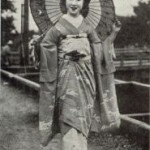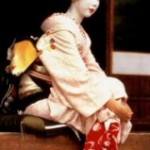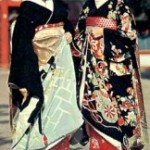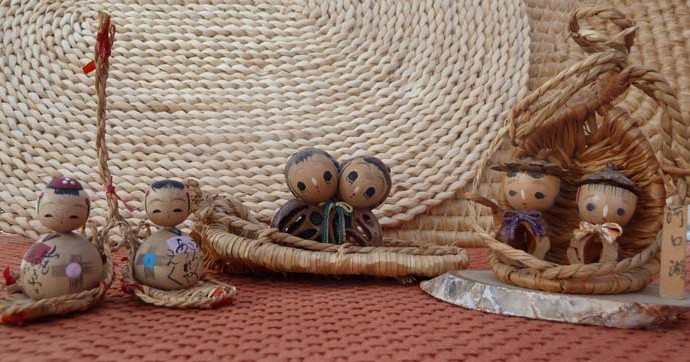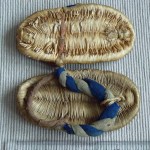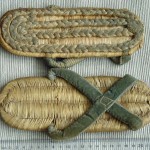I am pleased to announce the launch of the Straw Sandals Catalog at www.strawsandalscatalog.org. In collaboration with my old friend and colleague Barry Hall, we have constructed an on-line catalog of hand-crafted footwear. I will be posting more about this catalog in the coming days but simply stated, this catalog will allow anyone interested and connected to the internet to describe an item of hand-crafted, plant fiber footwear using a standardized response form and submit the description. The item will receive a unique catalog designation and the description will be publicly available. The initial entries into the catalog have been selected from the Straw Sandals Project collection. In future, we hope that the site will be used by academic scholars, museum staff, students and collectors.
The first entry is the Japanese Warazori J13 shown below:
In the catalog, this item has been described based on responses to 38 characters all of which have been assigned character states to standardize responses. To give you a sense of a description done in this manner, I have listed the description of J13 below:
Catalog ID: JpK1
Timestamp: 3/30/2012
Source and ID: Straw Sandals Project item J13
Style: Sandal attached to foot by toe thong(s) only (flip-flop)
Attachment of Sole to Vamp (Upper): Continuous
Sole Front Toe-loops: 0
Sole Side-toe loops: 0
Sole mid-sole loops: 0
Sole Side Heel-loops: 0
Sole Back Heel- loops: 0
Tie-system technique: Does not apply (no tie-system used)
Attached decorative element: None
Decoration: Pattern created by main construction technique
Sole Warp or Passive Element: Coarse, twisted, rounded element
Sole Weft or Active Element: Coarse, twisted, rounded element
Sole Bundle: Does not apply (no bundle used)
Sole warp or passive element yarn ply: 3 ply
Sole warp or passive element yarn twist: Z-twist
Sole weft or active element yarn ply: 2 ply
Sole weft or active element yarn twist: S-twist
Sole front edge finishing technique (selvage): Complex (contain added elements)
Sole back edge finishing technique (selvage): Complex (contain added elements)
Sole side edge finishing technique (selvage): Simple (produced from elements already in the sole)
Sole construction technique: 1 by 1 weft faced plainweave (warps and wefts used)
Sole warp material: Spun fibers
Sole weft material: Straw or grass
Sole solid (non-woven) material: Does not apply (sole not made of solid material)
Upper (Vamp + Quarter) Warp or Passive Element: Does not apply (no warp used)
Upper (Vamp + Quarter) Weft or Active Element: Coarse, twisted, rounded element
Upper (Vamp + Quarter) Bundle: Does not apply (no bundle used)
Upper (Vamp + Quarter) warp or passive element yarn ply: Does not apply (no warp used)
Upper (Vamp + Quarter) warp or passive element yarn twist: Does not apply (no warp used)
Upper (Vamp + Quarter) weft or active element yarn ply: 2 ply
Upper (Vamp + Quarter) weft or active element yarn twist: Z-twist
Upper (Vamp + Quarter) edge finishing technique (selvage): Complex (contain added elements)
Upper (Vamp + Quarter) construction technique: Non-woven vamp
Upper (Vamp + Quarter) warp material: Does not apply (Vamp made of solid material)
Upper (Vamp + Quarter) weft material: Cloth
Upper solid (non-woven) material: Does not apply (Vamp not made of solid material)
Structure of Upper: Vamp only
Overall Sole Shape: Symmetrical
Additional Information: Item J13 is a contemporary Warazori. The basic construction method is ancient and only straw was used. Here in a more modern rendition, cloth is used to start the flip-flop and end the flip-flop which is constructed from toe to heel. The cloth is wrapped around the four nylon warp elements to make a strong toe and heel part of the sole. In the classic construction, straw is used in place of cloth in the sole and straw is also used to construct the vamp.
There are 38 characters and the really neat thing about this approach is that the responses can be converted into a set of numbers, essentially a code that can be used by computer programs (algorithms) to organize and compare the descriptions in various ways. More on this later but here is the code for Warazori J13:
The code for describing this specimen is 1 1 1 1 1 1 1 -9 1 4 5 5 -9 3 3 2 2 3 3 2 2 1 2 -9 -9 5 -9 -9 -9 2 3 3 1 -9 6 -9 1 1
















